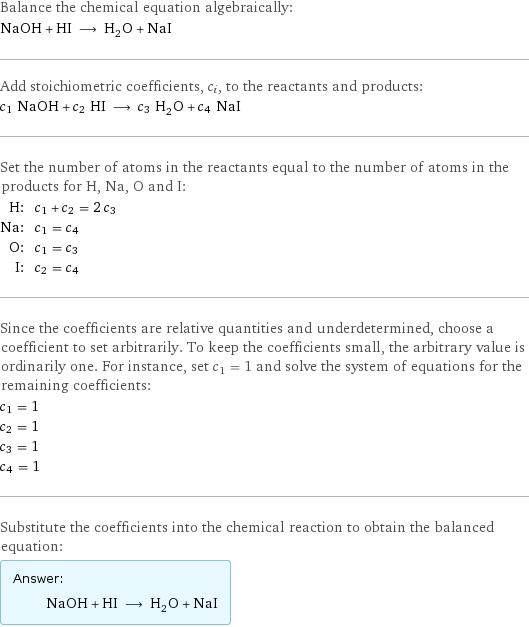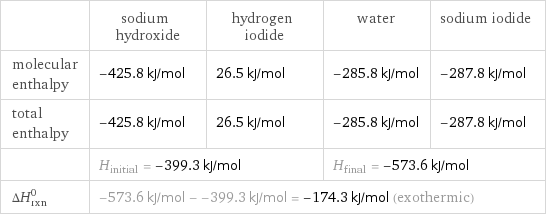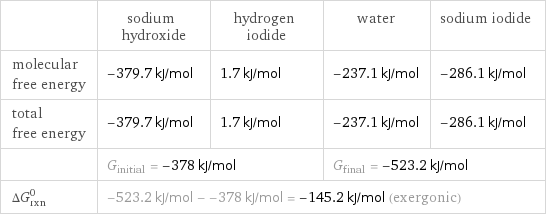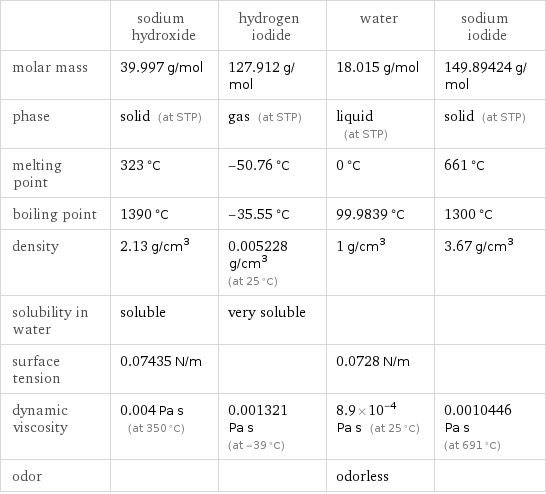Input interpretation

NaOH sodium hydroxide + HI hydrogen iodide ⟶ H_2O water + NaI sodium iodide
Balanced equation

Balance the chemical equation algebraically: NaOH + HI ⟶ H_2O + NaI Add stoichiometric coefficients, c_i, to the reactants and products: c_1 NaOH + c_2 HI ⟶ c_3 H_2O + c_4 NaI Set the number of atoms in the reactants equal to the number of atoms in the products for H, Na, O and I: H: | c_1 + c_2 = 2 c_3 Na: | c_1 = c_4 O: | c_1 = c_3 I: | c_2 = c_4 Since the coefficients are relative quantities and underdetermined, choose a coefficient to set arbitrarily. To keep the coefficients small, the arbitrary value is ordinarily one. For instance, set c_1 = 1 and solve the system of equations for the remaining coefficients: c_1 = 1 c_2 = 1 c_3 = 1 c_4 = 1 Substitute the coefficients into the chemical reaction to obtain the balanced equation: Answer: | | NaOH + HI ⟶ H_2O + NaI
Structures

+ ⟶ +
Names

sodium hydroxide + hydrogen iodide ⟶ water + sodium iodide
Reaction thermodynamics
Enthalpy

| sodium hydroxide | hydrogen iodide | water | sodium iodide molecular enthalpy | -425.8 kJ/mol | 26.5 kJ/mol | -285.8 kJ/mol | -287.8 kJ/mol total enthalpy | -425.8 kJ/mol | 26.5 kJ/mol | -285.8 kJ/mol | -287.8 kJ/mol | H_initial = -399.3 kJ/mol | | H_final = -573.6 kJ/mol | ΔH_rxn^0 | -573.6 kJ/mol - -399.3 kJ/mol = -174.3 kJ/mol (exothermic) | | |
Gibbs free energy

| sodium hydroxide | hydrogen iodide | water | sodium iodide molecular free energy | -379.7 kJ/mol | 1.7 kJ/mol | -237.1 kJ/mol | -286.1 kJ/mol total free energy | -379.7 kJ/mol | 1.7 kJ/mol | -237.1 kJ/mol | -286.1 kJ/mol | G_initial = -378 kJ/mol | | G_final = -523.2 kJ/mol | ΔG_rxn^0 | -523.2 kJ/mol - -378 kJ/mol = -145.2 kJ/mol (exergonic) | | |
Equilibrium constant
![Construct the equilibrium constant, K, expression for: NaOH + HI ⟶ H_2O + NaI Plan: • Balance the chemical equation. • Determine the stoichiometric numbers. • Assemble the activity expression for each chemical species. • Use the activity expressions to build the equilibrium constant expression. Write the balanced chemical equation: NaOH + HI ⟶ H_2O + NaI Assign stoichiometric numbers, ν_i, using the stoichiometric coefficients, c_i, from the balanced chemical equation in the following manner: ν_i = -c_i for reactants and ν_i = c_i for products: chemical species | c_i | ν_i NaOH | 1 | -1 HI | 1 | -1 H_2O | 1 | 1 NaI | 1 | 1 Assemble the activity expressions accounting for the state of matter and ν_i: chemical species | c_i | ν_i | activity expression NaOH | 1 | -1 | ([NaOH])^(-1) HI | 1 | -1 | ([HI])^(-1) H_2O | 1 | 1 | [H2O] NaI | 1 | 1 | [NaI] The equilibrium constant symbol in the concentration basis is: K_c Mulitply the activity expressions to arrive at the K_c expression: Answer: | | K_c = ([NaOH])^(-1) ([HI])^(-1) [H2O] [NaI] = ([H2O] [NaI])/([NaOH] [HI])](../image_source/1023ac4fa2735c5347058c8c0ebfacc0.png)
Construct the equilibrium constant, K, expression for: NaOH + HI ⟶ H_2O + NaI Plan: • Balance the chemical equation. • Determine the stoichiometric numbers. • Assemble the activity expression for each chemical species. • Use the activity expressions to build the equilibrium constant expression. Write the balanced chemical equation: NaOH + HI ⟶ H_2O + NaI Assign stoichiometric numbers, ν_i, using the stoichiometric coefficients, c_i, from the balanced chemical equation in the following manner: ν_i = -c_i for reactants and ν_i = c_i for products: chemical species | c_i | ν_i NaOH | 1 | -1 HI | 1 | -1 H_2O | 1 | 1 NaI | 1 | 1 Assemble the activity expressions accounting for the state of matter and ν_i: chemical species | c_i | ν_i | activity expression NaOH | 1 | -1 | ([NaOH])^(-1) HI | 1 | -1 | ([HI])^(-1) H_2O | 1 | 1 | [H2O] NaI | 1 | 1 | [NaI] The equilibrium constant symbol in the concentration basis is: K_c Mulitply the activity expressions to arrive at the K_c expression: Answer: | | K_c = ([NaOH])^(-1) ([HI])^(-1) [H2O] [NaI] = ([H2O] [NaI])/([NaOH] [HI])
Rate of reaction
![Construct the rate of reaction expression for: NaOH + HI ⟶ H_2O + NaI Plan: • Balance the chemical equation. • Determine the stoichiometric numbers. • Assemble the rate term for each chemical species. • Write the rate of reaction expression. Write the balanced chemical equation: NaOH + HI ⟶ H_2O + NaI Assign stoichiometric numbers, ν_i, using the stoichiometric coefficients, c_i, from the balanced chemical equation in the following manner: ν_i = -c_i for reactants and ν_i = c_i for products: chemical species | c_i | ν_i NaOH | 1 | -1 HI | 1 | -1 H_2O | 1 | 1 NaI | 1 | 1 The rate term for each chemical species, B_i, is 1/ν_i(Δ[B_i])/(Δt) where [B_i] is the amount concentration and t is time: chemical species | c_i | ν_i | rate term NaOH | 1 | -1 | -(Δ[NaOH])/(Δt) HI | 1 | -1 | -(Δ[HI])/(Δt) H_2O | 1 | 1 | (Δ[H2O])/(Δt) NaI | 1 | 1 | (Δ[NaI])/(Δt) (for infinitesimal rate of change, replace Δ with d) Set the rate terms equal to each other to arrive at the rate expression: Answer: | | rate = -(Δ[NaOH])/(Δt) = -(Δ[HI])/(Δt) = (Δ[H2O])/(Δt) = (Δ[NaI])/(Δt) (assuming constant volume and no accumulation of intermediates or side products)](../image_source/531eb2443d1e1aad29dc5f488c8ad6ba.png)
Construct the rate of reaction expression for: NaOH + HI ⟶ H_2O + NaI Plan: • Balance the chemical equation. • Determine the stoichiometric numbers. • Assemble the rate term for each chemical species. • Write the rate of reaction expression. Write the balanced chemical equation: NaOH + HI ⟶ H_2O + NaI Assign stoichiometric numbers, ν_i, using the stoichiometric coefficients, c_i, from the balanced chemical equation in the following manner: ν_i = -c_i for reactants and ν_i = c_i for products: chemical species | c_i | ν_i NaOH | 1 | -1 HI | 1 | -1 H_2O | 1 | 1 NaI | 1 | 1 The rate term for each chemical species, B_i, is 1/ν_i(Δ[B_i])/(Δt) where [B_i] is the amount concentration and t is time: chemical species | c_i | ν_i | rate term NaOH | 1 | -1 | -(Δ[NaOH])/(Δt) HI | 1 | -1 | -(Δ[HI])/(Δt) H_2O | 1 | 1 | (Δ[H2O])/(Δt) NaI | 1 | 1 | (Δ[NaI])/(Δt) (for infinitesimal rate of change, replace Δ with d) Set the rate terms equal to each other to arrive at the rate expression: Answer: | | rate = -(Δ[NaOH])/(Δt) = -(Δ[HI])/(Δt) = (Δ[H2O])/(Δt) = (Δ[NaI])/(Δt) (assuming constant volume and no accumulation of intermediates or side products)
Chemical names and formulas

| sodium hydroxide | hydrogen iodide | water | sodium iodide formula | NaOH | HI | H_2O | NaI Hill formula | HNaO | HI | H_2O | INa name | sodium hydroxide | hydrogen iodide | water | sodium iodide
Substance properties

| sodium hydroxide | hydrogen iodide | water | sodium iodide molar mass | 39.997 g/mol | 127.912 g/mol | 18.015 g/mol | 149.89424 g/mol phase | solid (at STP) | gas (at STP) | liquid (at STP) | solid (at STP) melting point | 323 °C | -50.76 °C | 0 °C | 661 °C boiling point | 1390 °C | -35.55 °C | 99.9839 °C | 1300 °C density | 2.13 g/cm^3 | 0.005228 g/cm^3 (at 25 °C) | 1 g/cm^3 | 3.67 g/cm^3 solubility in water | soluble | very soluble | | surface tension | 0.07435 N/m | | 0.0728 N/m | dynamic viscosity | 0.004 Pa s (at 350 °C) | 0.001321 Pa s (at -39 °C) | 8.9×10^-4 Pa s (at 25 °C) | 0.0010446 Pa s (at 691 °C) odor | | | odorless |
Units
